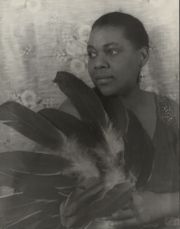Classic female blues
2007 Schools Wikipedia Selection. Related subjects: Musical genres, styles, eras and events
The classic female blues spanned from 1920 to 1929 with its peak from 1923 to 1925. The most popular of these singers were Ma Rainey, Bessie Smith, Mamie Smith, Ethel Waters, Ida Cox, Victoria Spivey, Sippie Wallace, Alberta Hunter, Clara Smith, Edith Wilson, Trixie Smith, Lucille Hegamin and Bertha “Chippie” Hill. Hundreds of others recorded including Lizzie Miles, Sara Martin, Rosa Henderson, Martha Copeland, Bessie Jackson (Lucille Bogan), Edith Johnson, Katherine Baker, Margaret Johnson, Hattie Burleson, Madlyn Davis, Ivy Smith, Alberta Brown, Gladys Bentley, Billie and Ida Goodson, Fannie May Goosby, Bernice Edwards and Florence Mills.
They sang often backed behind their bands consisting of piano, several horns and drums. These women were pioneers in the record industry by being the first black voices recorded and also by spreading the 12-bar blues form through out the country. In terms of performing, they often wore elaborate outfits and sang of the injustices of their lives, bonding with their audience’s sorrows. Their schedules were grueling, staying on the road most of the time with tent shows in the summer and theatres during the winter. With the crash of Wall Street in 1929, the popularity of the blues singers declined. Some went back home, took up jobs or moved to Hollywood. In the ‘60s with the blues revival, Sippie Wallace, Alberta Hunter, Edith Wilson and Victoria Spivey returned to the stage.
Gertrude “Ma” Rainey, form Georgia, was the “ Mother of the Blues,” and lived from 1886-1939. She was the first woman to incorporate blues into her act of show songs and comedy. In 1902, she heard a woman singing about the man she’d lost, and quickly learned the song. From then on at each performance, she used it as her closing number calling it “the blues.” She recorded over 100 songs and wrote 24 of them herself. “Bessie (Smith and all the others who followed in time), wrote jazz historian Dan Morgenstern “learned their art and craft from Ma, directly or indirectly.” Young women followed Ma Rainey’s path in the tent show circuit, since black performers were not allowed to be in venues. Eventually most singers were booked on the T.O.B.A. (Theatre Owners Booking Association) circuit.
Mamie Smith, “America’s First Lady of the Blues,” was the first black woman to record the blues in 1920. Harlem songwriter/music publisher, Perry Bradford, brought Smith by the Okeh studio to get his songs heard. Sophie Tucker was ill on the day of her session and Okeh allowed Smith to record. They recorded two non-blues songs but were brought back into the studio to record a blues song six months later. All of the recording band members claimed different titles for the song that became known as “Crazy Blues.” The song sold over 17,000 copies in its first month. This affected the recording industry so that hundreds of black female singers began being scouted, booked and recorded.
The most popular of these women was Tennessee-born Bessie Smith. She was known as the “Empress of the Blues.” She possessed a large voice with a “T’ain’t Nobody’s Bizness If I Do” attitude. Bessie was a dancer before she was a singer, but was let go because her skin colour was too dark. She also struggled initially with being recorded—three companies turned her down before she was signed with Columbia. She eventually became the highest-paid black artist of the ‘20s, but by the ‘30s she was making half as much as her usual salary. She died in a car crash in 1937, at the age of 41. Lionel Hampton is quoted as saying, “Had she lived, Bessie would’ve been right up there on top with the rest of us in the Swing Era.” Mahalia Jackson and Janis Joplin both claimed to have drawn great inspiration from her singing. Her work is well documented in print as well as recording with over 160 songs currently available.
Hailing from Texas were Victoria Spivey and her cousin Sippie Wallace. Victoria Spivey was influenced after a Mamie Smith performance to become a blues singer. At 16, she became an overnight success with Okey’s release of her original song, “Black Snake Blues.” She also appeared in the first all-black talking film. She continued performing through out her life with a brief hiatus in the ‘50s. She was the only classic blues singer to have her own record label, Spivey Records. In addition to recording herself, she recorded Lucille Hegamin, Memphis Slim, Lonnie Johnson and others. As a songwriter, pianist and singer, she produced over 1,500 songs. She died in 1976 at the age of 70.
